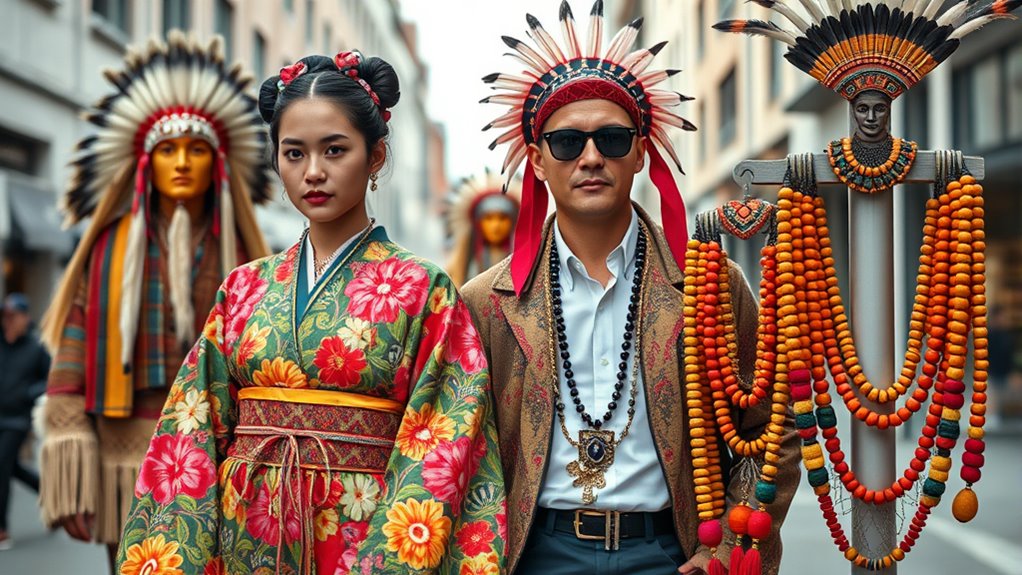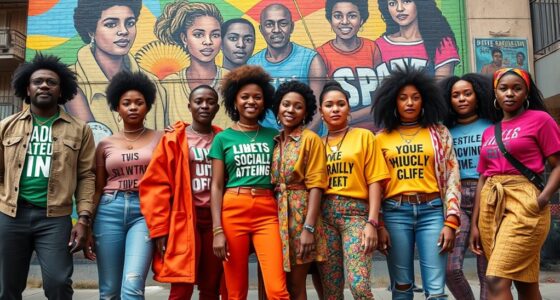Cultural appreciation in fashion means valuing and respectfully celebrating another culture’s symbols, styles, or practices, understanding their meaning and significance. Cultural appropriation happens when you adopt these elements superficially or without respect, often stripping away their cultural context or using them for trendiness. Recognizing the difference helps you make responsible choices that honor communities and their traditions. To learn how to navigate this delicate line thoughtfully, continue exploring how to appreciate cultures authentically.
Key Takeaways
- Cultural appreciation involves respectful acknowledgment and understanding of another culture’s symbols and practices, while appropriation lacks this respect.
- Appropriation often commodifies or trivializes cultural elements, whereas appreciation honors their significance and context.
- Recognizing the origins and meaning of cultural symbols helps differentiate respectful admiration from harmful appropriation.
- Engaging with communities and seeking permission promotes ethical cultural exchange in fashion.
- Avoiding stereotypes and ensuring fair compensation are essential to respectful cultural appreciation in fashion design.
Defining Cultural Appreciation and Cultural Appropriation in Fashion
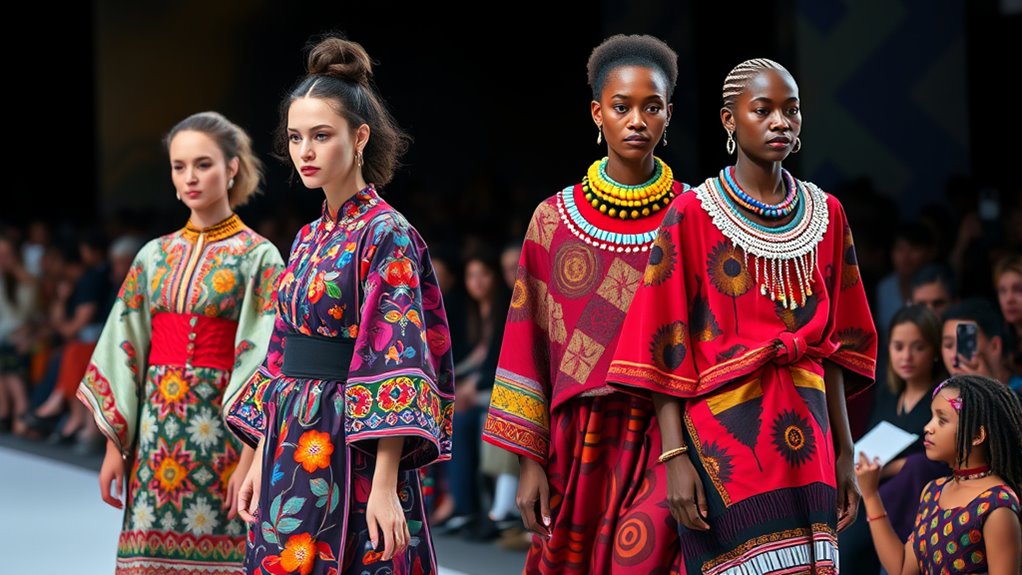
Understanding the difference between cultural appreciation and cultural appropriation in fashion is essential because it shapes how you respect and honor diverse traditions. Cultural appreciation involves genuinely valuing and celebrating the significance of another culture’s symbols, styles, or practices. It’s about learning and engaging with respect, often through education or collaboration. Conversely, cultural appropriation occurs when you adopt elements of a culture without understanding or respecting their meaning, often for personal gain or trendiness. It can perpetuate stereotypes and diminish the original significance. Recognizing this distinction helps you make mindful choices, ensuring your fashion choices honor the source cultures rather than exploit them. Being aware fosters respectful appreciation rather than harmful appropriation, promoting cultural understanding rather than misrepresentation. Additionally, understanding projector technology can help you appreciate the craftsmanship and innovation behind cultural designs, fostering deeper respect. Developing an awareness of cultural symbolism can also enhance your ability to distinguish between respectful homage and superficial trend adoption. When you educate yourself about the design origins of cultural elements, you can avoid unintentional disrespect and support authentic representation. Recognizing the craftsmanship and techniques involved in creating cultural artifacts further enriches your appreciation and encourages respectful engagement.
Historical Examples of Cultural Borrowing in Style
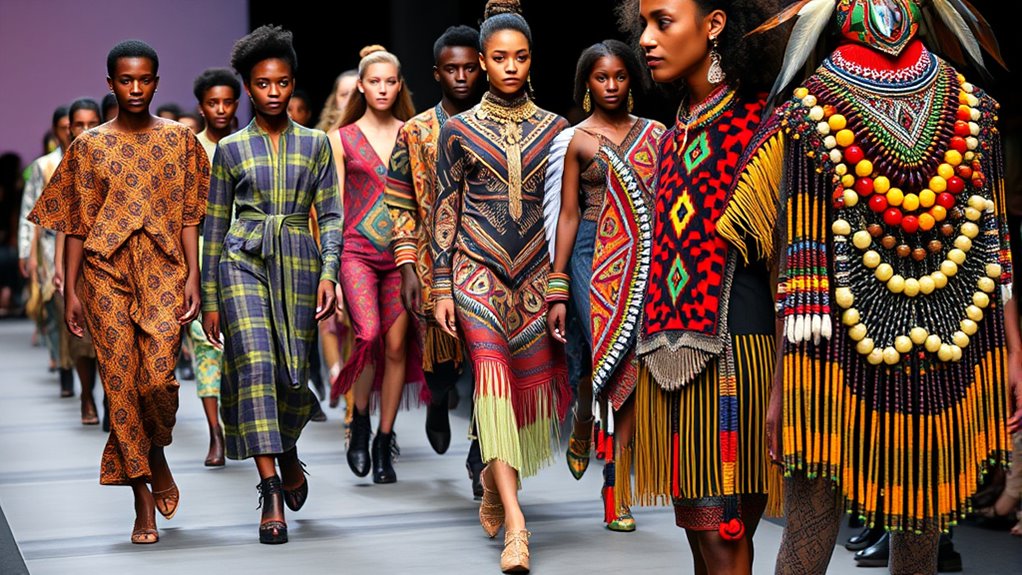
Throughout history, fashion has often borrowed elements from different cultures, sometimes with little regard for their significance. You’ve likely seen Western designers incorporate kimono styles, Native American patterns, or African textiles into their collections. These examples highlight how cultural influences can shape style, but also raise questions about respect and authenticity. Self Watering Plant Pots exemplify a modern innovation that simplifies plant care while respecting the natural growth process. Similarly, the use of cultural motifs in fashion can reflect appreciation or appropriation, depending on context and intent. Recognizing the importance of cultural sensitivity is crucial in fostering respectful and authentic style exchanges.
Kimono in Western Fashion
Have you ever noticed how the kimono has made its way into Western fashion? It’s appeared in runway shows, designer collections, and even everyday clothing. In the early 20th century, Western designers borrowed kimono-inspired silhouettes, incorporating wide sleeves and obi-like belts into their garments. The 1960s saw the kimono influence in bohemian and hippie styles, emphasizing relaxed fabrics and floral patterns reminiscent of traditional kimono fabrics. High-profile fashion houses, like Yves Saint Laurent and Gucci, have integrated kimono elements into their collections, often blending them with Western styles. While some see this as cultural appreciation, others argue it commodifies and distorts a sacred garment. Incorporation of natural elements like silk and intricate patterns into fashion design highlights a long history of cultural borrowing—sometimes respectful, sometimes controversial.
Native American Patterns
Did you know that Native American patterns have long influenced Western fashion, often appearing in ways that spark debate? These designs, rooted in cultural significance, have been adapted beyond their original meanings. Over time, they’ve shown up in clothing, accessories, and runway collections, sometimes without proper acknowledgment. This appropriation raises questions about respect and authenticity. To understand this influence better, consider these points:
- Native patterns often feature geometric shapes symbolizing spiritual beliefs.
- Western designers have incorporated these patterns into mainstream fashion without consulting Indigenous communities.
- The use of these patterns can strip away their cultural context, reducing them to mere aesthetics.
- This history highlights the importance of respecting origins and understanding the significance behind cultural designs.
- Awareness of cultural sensitivity can help prevent misappropriation and promote respectful appreciation of indigenous art, emphasizing the need for cultural education to foster understanding.
- Recognizing the historical context of these patterns is essential to appreciating their true meaning and significance.
- Incorporating these patterns without acknowledgment can also diminish the cultural value they hold for Indigenous peoples, underscoring the importance of ethical cultural exchange.
- Learning about cultural preservation can support Indigenous communities in maintaining their artistic traditions and prevent further cultural loss.
African Textiles in Haute Couture
African textiles have long served as a rich source of inspiration for haute couture designers seeking to infuse their creations with cultural depth. Designers like Yves Saint Laurent and Jean Paul Gaultier have incorporated bold African prints and intricate patterns into their runway shows, often blending traditional motifs with modern silhouettes. In the 1960s, designers embraced Ankara fabrics, elevating them from everyday wear to high fashion, while recent collections feature Kente cloth and mudcloth as statement pieces. These examples highlight a history of cultural borrowing that celebrates African artistry, but they also raise questions about authenticity and respect. When you incorporate African textiles into your designs, it’s essential to honor their origins and avoid superficial or exploitative use, ensuring appreciation doesn’t cross into cultural appropriation.
Key Differences Between Respectful Inspiration and Exploitative Use
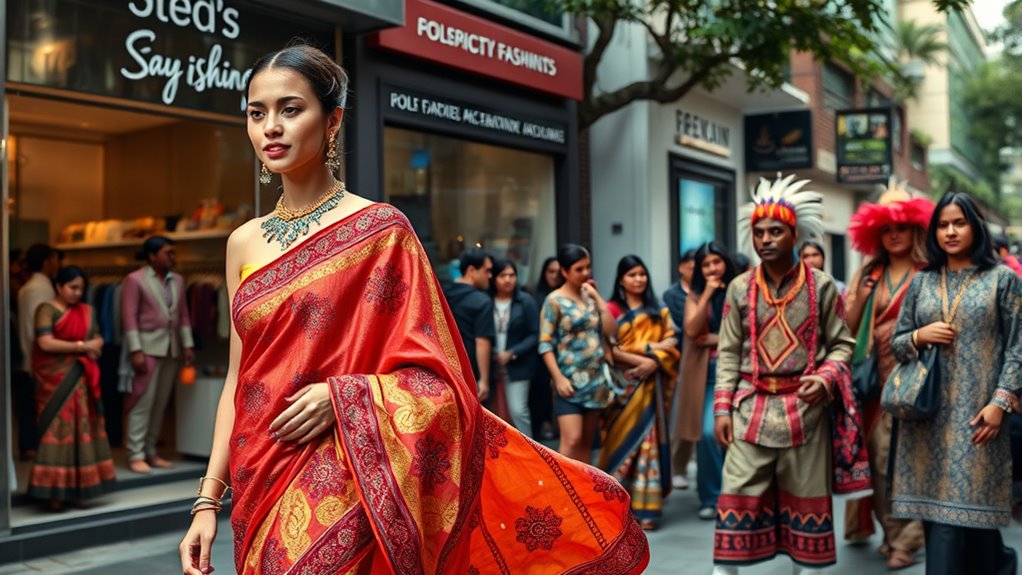
You can tell the difference between respectful inspiration and exploitative use by examining the intent and context behind the fashion choice. When you honor a culture’s significance and approach it with genuine respect, your actions are more likely to be appreciated. Conversely, if the cultural elements are used superficially or without understanding, it risks crossing into exploitation. Recognizing cultural significance can help ensure that your fashion choices are respectful rather than appropriative. Additionally, understanding the ethical boundaries involved in cultural expression can guide responsible and considerate fashion decisions. Being aware of the history and symbolism behind certain styles can further deepen your appreciation and prevent misappropriation. Incorporating cultural context into your understanding allows for a more meaningful and respectful appreciation of diverse traditions. Moreover, embracing a design thinking mindset can foster more empathetic and inclusive approaches to cultural representation in fashion.
Intent and Context
Understanding the difference between respectful inspiration and exploitative use hinges on examining intent and context. Your purpose matters: are you honoring a culture’s beauty or profiting without acknowledgment? Context also shapes perception: is the design rooted in genuine admiration or rooted in stereotypes? To evaluate this, consider:
- The creator’s background and relationship to the culture
- Whether the design is meant to celebrate or trivialize cultural symbols
- If the use involves cultural insiders or outsiders
- The potential impact on the community involved
- The level of Cultural Intelligence demonstrated in understanding and respecting cultural nuances, including awareness of cultural sensitivities in diverse contexts. Recognizing the importance of cultural awareness can help prevent harmful misappropriations and promote respectful appreciation. Incorporating cultural education into design processes ensures a more informed and respectful approach to cultural elements. Developing cultural competence can further enhance understanding and foster genuine respect in creative expressions.
Cultural Significance Respect
Respecting cultural significance means recognizing that certain symbols, traditions, and practices carry deep meaning for their communities. When you incorporate cultural elements thoughtfully, you honor their origins and avoid reducing them to mere trends. It’s about understanding the history and significance behind what you’re inspired by, rather than superficial copying. Respectful inspiration involves engaging with communities, seeking permission, or collaborating to ensure your use is genuine and considerate. Exploitative use, however, strips these symbols of their meaning for profit or aesthetic appeal, disregarding their cultural context. By prioritizing respect, you acknowledge the importance of protecting cultural identity and promoting authentic appreciation, rather than risking offense or cultural dilution. This approach fosters understanding and shows that you value the richness of diverse traditions. Additionally, understanding cultural significance helps prevent unintentional misappropriation and fosters more meaningful cross-cultural exchanges. Recognizing cultural context can also guide you in making more informed and respectful choices when drawing inspiration from other cultures. Moreover, being aware of cultural symbolism can help ensure that your fashion choices do not unintentionally perpetuate stereotypes or misconceptions. Incorporating an awareness of cultural history further deepens appreciation and ensures respectful representation. Developing an understanding of cultural expressions can also help you appreciate the diversity within traditions and avoid homogenizing complex cultural identities.
The Impact of Cultural Appropriation on Communities

Cultural appropriation can have profound and often harmful effects on communities, especially when their traditions and symbols are used without acknowledgment or sensitivity. It can lead to feelings of disrespect, marginalization, and erasure of cultural identity. When you use cultural elements without understanding their significance, you risk perpetuating stereotypes and undermining their true meaning. This can cause community members to feel disrespected or exploited. Additionally, it can diminish the value of their cultural practices, making them seem superficial or trendy. The impact extends beyond individual feelings, affecting community cohesion and cultural preservation.
Cultural appropriation harms communities by erasing identities, reinforcing stereotypes, and exploiting cultural practices.
- Erosion of cultural identity
- Reinforcement of stereotypes
- Economic exploitation
- Loss of cultural sovereignty
Recognizing Sacred Symbols and Their Significance
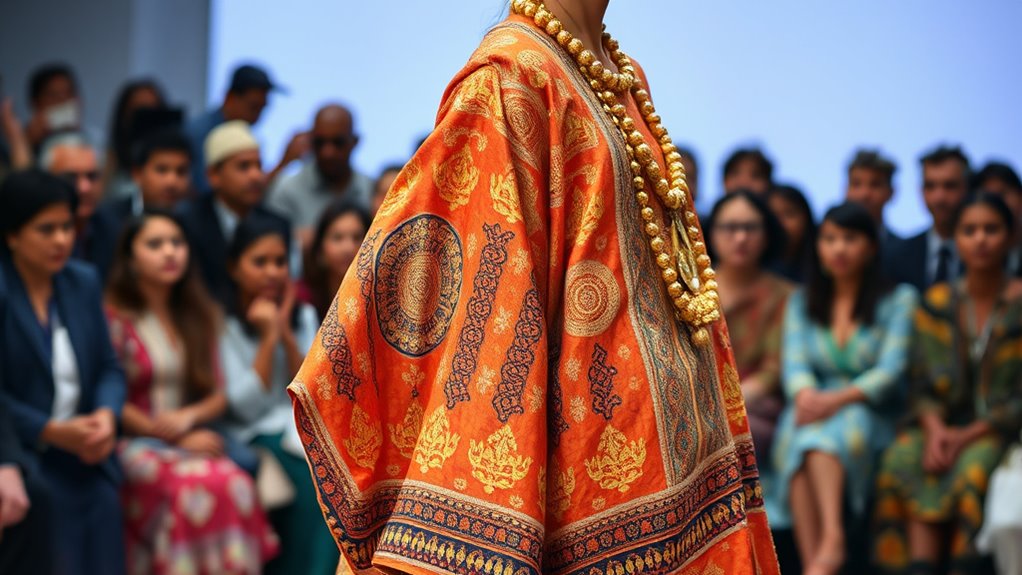
Sacred symbols hold deep spiritual and cultural significance for many communities, serving as representations of their beliefs, history, and identity. When you encounter these symbols, recognize that they are more than mere designs—they embody the core values and sacred traditions of the people who venerate them. Wearing or using these symbols without understanding their meaning can be disrespectful and harmful. Take the time to learn about their origins, significance, and the context in which they are used. Respect the boundaries set by the community, and avoid trivializing or commodifying symbols that hold sacred importance. By doing so, you foster respect and awareness, helping prevent cultural misappropriation from crossing into insensitivity or offense.
Ethical Considerations for Designers and Brands

As a designer or brand, you have a responsibility to respect the cultural significance behind the styles you use. Collaborate with communities authentically and seek their input to guarantee your work is respectful. Additionally, make sure to provide fair compensation to those whose culture you’re drawing from.
Respect Cultural Significance
When designing or promoting fashion inspired by different cultures, respecting the cultural significance behind certain symbols, attire, or practices isn’t just polite—it’s essential. Ignoring this can lead to misrepresentation or offense. To guarantee respectful engagement, consider these points:
- Research the history and meaning of cultural elements before using them.
- Avoid stripping symbols of their significance or customizing them without understanding.
- Recognize that some items or practices are sacred or reserved for specific community members.
- Seek permission or guidance from cultural representatives when appropriate.
Collaborate Authentically
Collaborating authentically with cultural communities is essential for brands and designers aiming to respect and honor the origins of their inspiration. You should seek genuine partnerships rather than superficial gestures, building relationships based on trust and mutual understanding. Engage with community members early in the design process, listening to their stories and perspectives. Be transparent about your intentions, ensuring that your collaboration benefits those whose culture you’re drawing from. Avoid tokenism by involving community voices consistently, not just for marketing. Respect cultural protocols and seek permission when necessary. This approach fosters genuine appreciation and minimizes exploitation. Remember, authentic collaboration isn’t just about avoiding missteps; it’s about creating meaningful connections that honor cultural integrity and contribute positively to the community.
Ensure Fair Compensation
Ensuring fair compensation is a crucial step for brands and designers to ethically honor the cultures they draw inspiration from. When you incorporate elements from a community, it’s your responsibility to recognize their contributions. This means paying artisans, artisans’ cooperatives, or cultural groups fairly for their work and knowledge. Doing so not only supports sustainable livelihoods but also fosters trust and respect.
To ensure fair compensation:
- Research appropriate payment standards within the community or industry.
- Establish transparent agreements that specify compensation terms upfront.
- Collaborate directly with cultural representatives or artisans.
- Invest in community development projects to give back beyond monetary payments.
How Consumers Can Support Respectful Cultural Representation
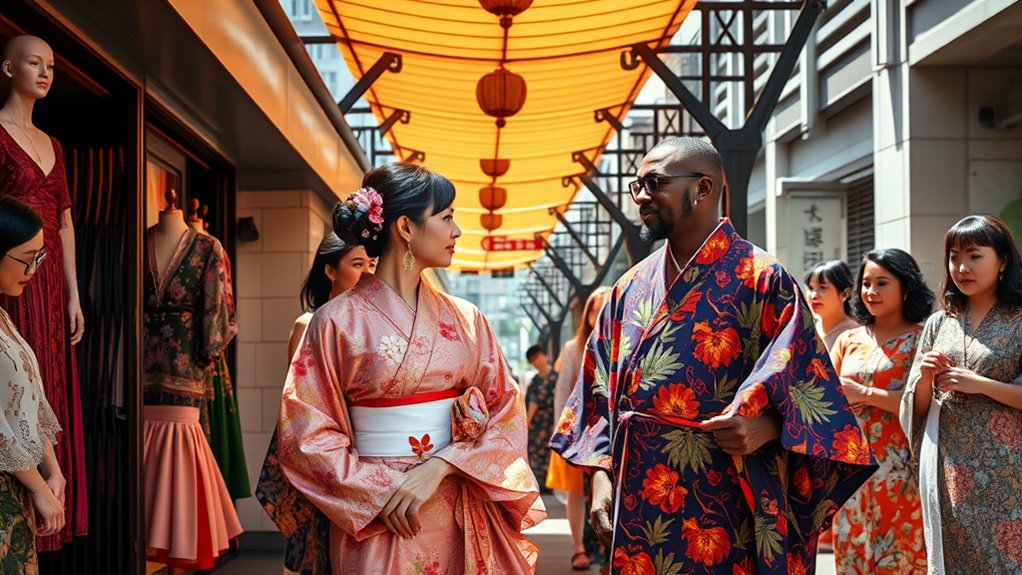
Supporting respectful cultural representation starts with being an informed consumer. Take the time to learn about different cultures and their significance beyond superficial stereotypes. When shopping, seek out brands that collaborate directly with cultural communities or prioritize ethical practices. Ask questions about the origins of garments or accessories—are they made with respect and understanding? Support designers and companies that promote cultural appreciation rather than appropriation, and be wary of trends that commodify cultural symbols. Use your voice—share knowledge and encourage others to recognize the difference between appreciation and exploitation. Your choices can foster a more respectful fashion industry that values authenticity and cultural integrity. By being conscious of where and how you spend, you help promote respectful, meaningful representation of diverse cultures.
Case Studies of Controversial Fashion Moments
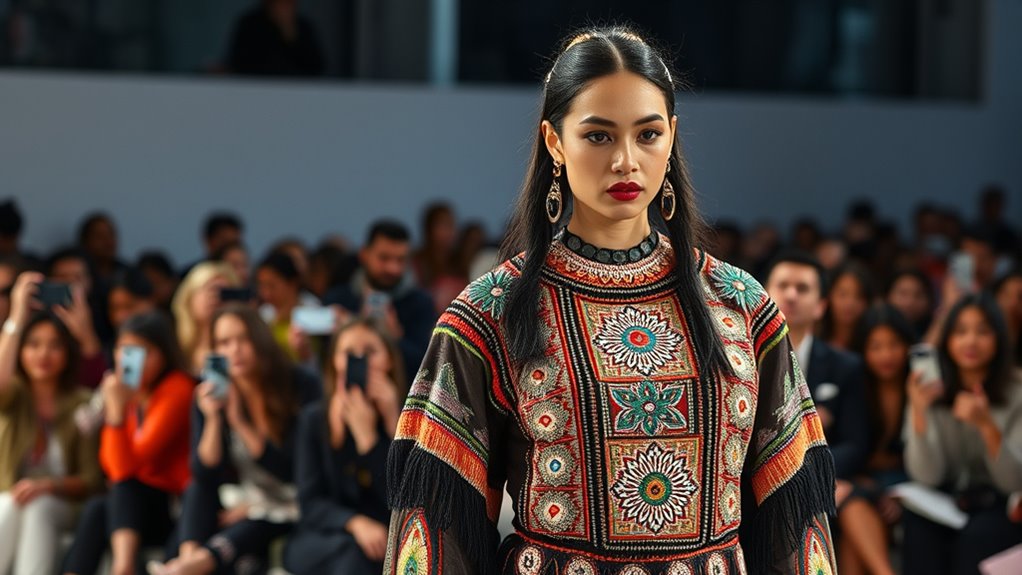
Throughout fashion history, some moments have sparked intense debate by crossing the line between cultural appreciation and outright controversy. These cases highlight how intent, context, and representation matter. For example:
- Victoria’s Secret Native American Headdresses (2012): The brand faced backlash for using headdresses as fashion accessories, dismissing their sacred significance.
- Gucci’s Turban (2018): The luxury brand released a turban-inspired accessory, sparking accusations of cultural insensitivity.
- Marc Jacobs Dreadlocks (2016): The designer faced criticism for using dreadlocks on models, seen as trivializing Black culture.
- Vivienne Westwood’s “Satirical” T-shirts: Some designs appropriated religious and cultural symbols, igniting debates about respect and context.
These moments serve as cautionary tales about the importance of understanding cultural symbols.
Strategies for Culturally Sensitive Design Practices
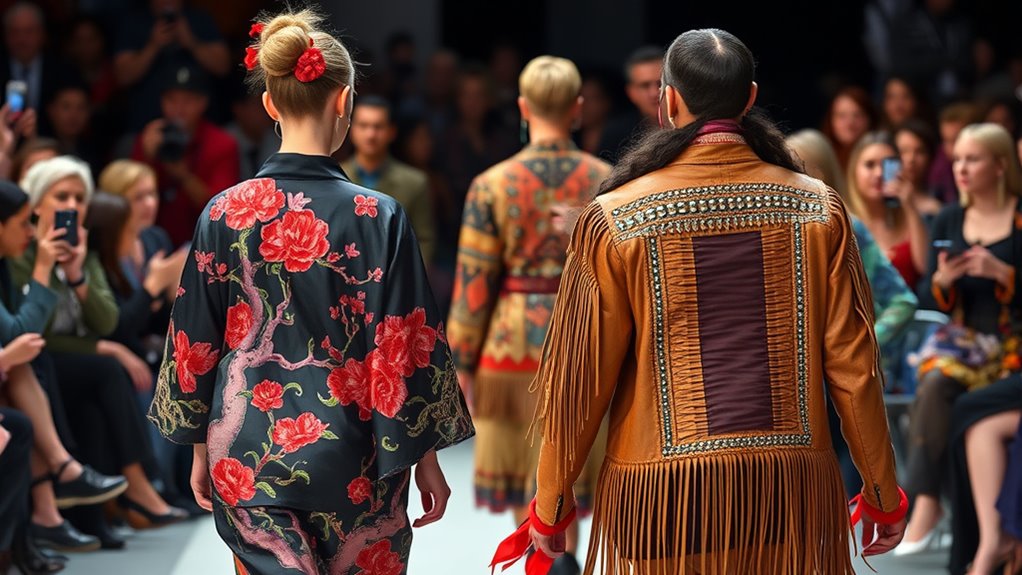
To create culturally sensitive designs, you need to start by conducting thorough research on the cultural symbols, traditions, and histories you wish to incorporate. Engage with community members or cultural experts to gain authentic insights, ensuring you understand the context and significance behind specific elements. Avoid stereotypes and superficial representations; instead, aim for respectful and accurate portrayals. Always ask for permission if you’re directly using cultural artifacts or symbols, and give proper credit when possible. Collaborate with cultural consultants to review your designs, making adjustments based on their feedback. Be open to learning and willing to adapt your approach to avoid misrepresentation or offense. By prioritizing respect and understanding, you can create designs that honor and celebrate cultures genuinely.
Promoting Cultural Exchange Without Cultural Exploitation
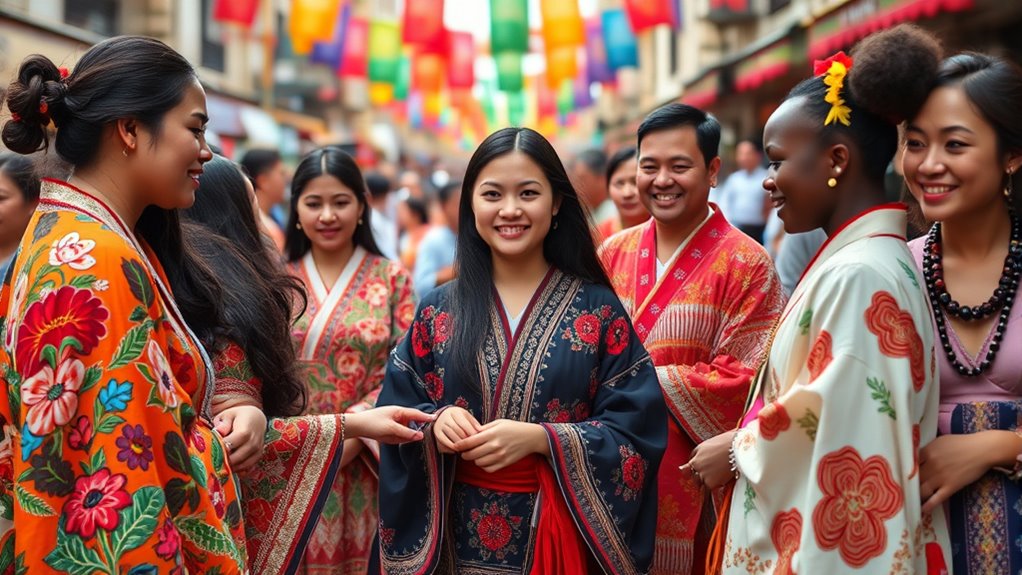
When engaging with other cultures through fashion, it’s important to foster genuine exchange rather than perpetuate exploitation. Respect and understanding should guide your efforts to celebrate cultural diversity. To promote meaningful exchange, consider these steps:
Foster genuine cultural exchange by respecting, understanding, and supporting authentic creators in fashion.
- Educate yourself about the culture’s history, significance, and context behind the designs.
- Collaborate directly with members of the culture to ensure authentic representation.
- Support artisans and local creators by purchasing their work or sharing their stories.
- Be transparent about your sources and intentions, avoiding stereotypes or misappropriation.
Frequently Asked Questions
How Can Designers Ensure Cultural Authenticity in Their Collections?
You can guarantee cultural authenticity in your collections by actively researching the origins and significance of the cultural elements you want to include. Engage with community members or cultural experts to gain insights and permissions. Respect traditions and avoid stereotypes, emphasizing collaboration rather than appropriation. By doing so, you demonstrate genuine appreciation and ensure your designs honor the culture’s true essence. This approach fosters respect and authenticity in your fashion creations.
What Role Do Fashion Influencers Play in Cultural Appreciation?
Picture passionate influencers promoting powerful, positive perspectives. You see them showcasing cultural customs with care, celebrating diversity through deliberate, respectful displays. Influencers amplify authentic appreciation by advocating for awareness, acting as ambassadors who bridge cultures with boldness and balance. They educate followers, elevate voices, and encourage empathetic exploration. Your role is to support influencers who promote genuine understanding, helping to foster a fashion scene that respects and reveres cultural roots rather than misappropriating them.
How Do Cultural Stereotypes Influence Fashion Choices?
You notice that cultural stereotypes often influence fashion choices by shaping what you think is trendy or acceptable. These stereotypes can lead you to pick styles that reinforce misconceptions or oversimplify cultures. While fashion can celebrate diversity, it’s important to be aware of stereotypes and avoid perpetuating them. By choosing thoughtfully, you can express your style respectfully and authentically, honoring cultures without reducing them to clichés.
Can Cultural Appropriation Ever Be Completely Avoided in Global Fashion?
You wonder if cultural appropriation can ever be fully avoided in global fashion. While it’s challenging, you can minimize it by respecting cultural origins, seeking permission, and understanding significance. When you educate yourself and support authentic creators, you help foster appreciation rather than appropriation. Though perfect avoidance is tough, your mindful choices make a difference, showing respect for cultures and promoting ethical fashion practices worldwide.
What Legal Protections Exist for Indigenous Cultural Symbols in Fashion?
You may wonder what legal protections exist for indigenous cultural symbols in fashion. While laws vary globally, some countries recognize intellectual property rights, trademarks, and cultural heritage protections that can prevent unauthorized use. Indigenous groups can also pursue legal action if their symbols are misappropriated or commercialized without permission. However, enforcement is often complex, and awareness is growing for respecting cultural significance through legal channels and ethical practices.
Conclusion
By understanding the difference between appreciation and appropriation, you can make mindful choices in fashion. Instead of unintentionally disrespecting cultures, you can celebrate diversity respectfully—imagine walking into a store where every piece honors its origins. Your awareness helps protect sacred symbols and supports authentic representation. When you choose thoughtfully, you foster genuine cultural exchange, creating a world where fashion unites rather than divides. Together, you can wear your values proudly and ethically.
